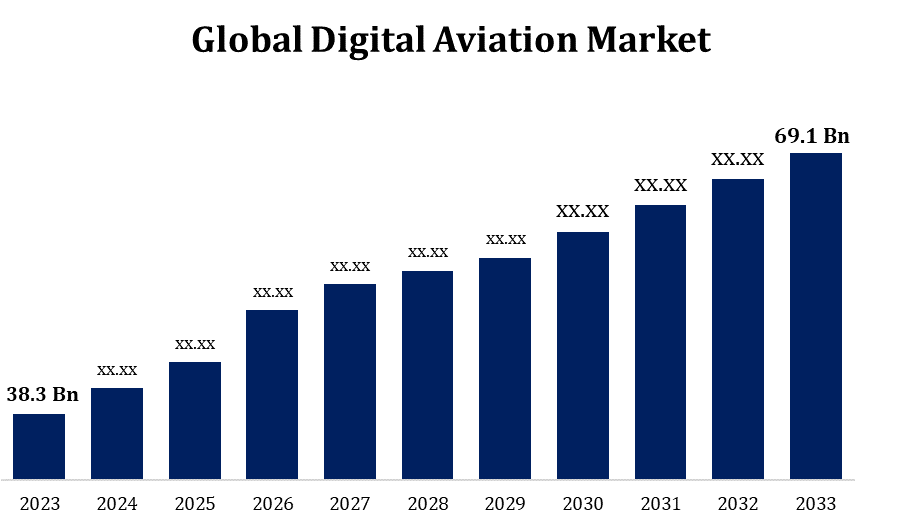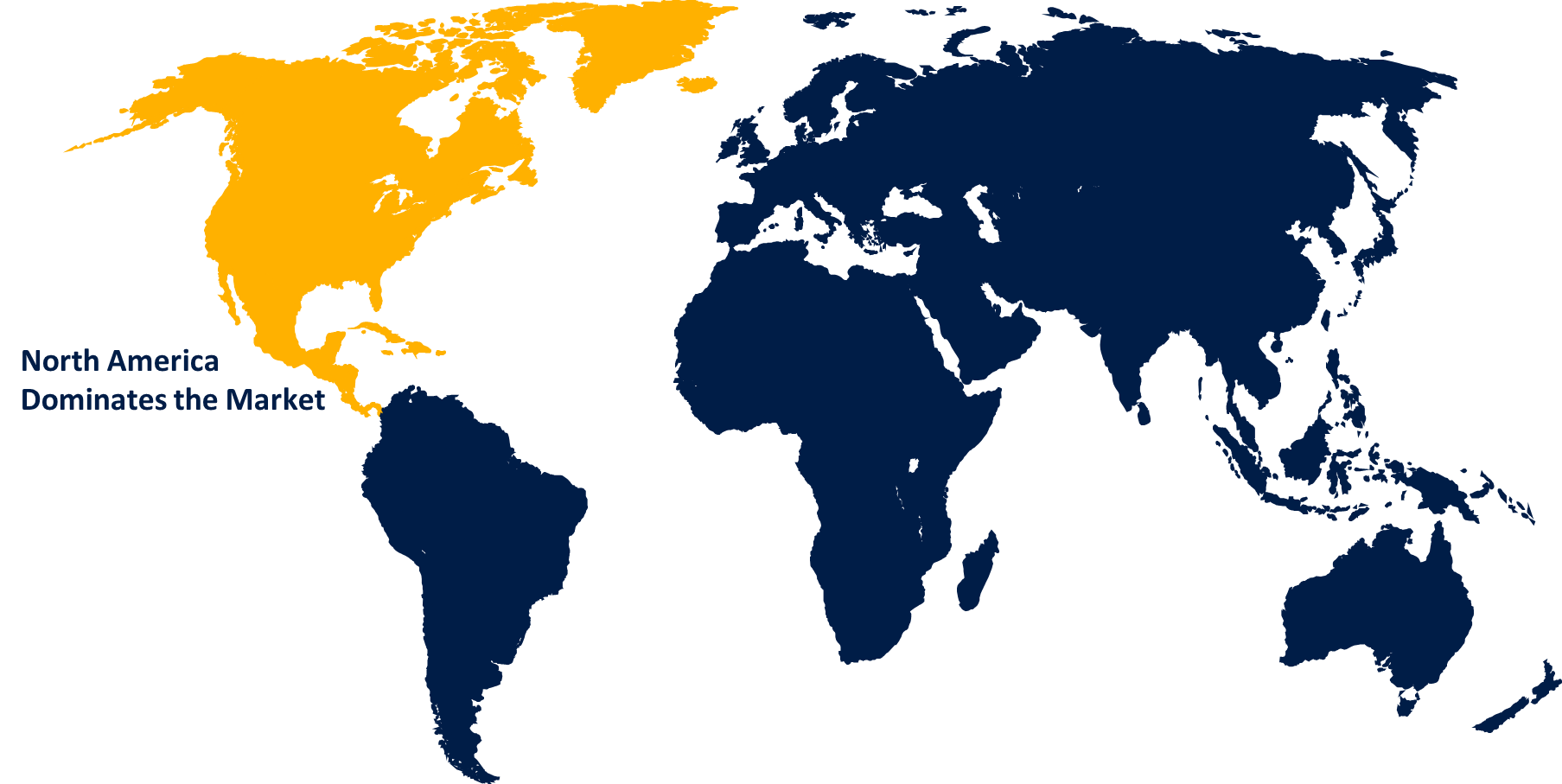Global Digital Aviation Market Size, Share, and COVID-19 Impact Analysis, By Solution (Software and Services), By Connectivity (Satellite Connectivity and Cloud Connectivity), By Platform (Commercial & Civil, Military, and General Aviation), and By Region (North America, Europe, Asia-Pacific, Latin America, Middle East, and Africa), Analysis and Forecast 2023 - 2033
Industry: Aerospace & DefenseGlobal Digital Aviation Market Insights Forecasts to 2033
- The Digital Aviation Market Size was valued at USD 38.3 Billion in 2023.
- The Market Size is Growing at a CAGR of 6.08% from 2023 to 2033
- The Worldwide Digital Aviation Market Size is expected to reach USD 69.1 Billion by 2033
- Asia Pacific is expected to Grow the fastest during the forecast period

Get more details on this report -
The Global Digital Aviation Market is Expected to reach USD 69.1 billion by 2033, at a CAGR of 6.08% during the forecast period 2023 to 2033.
The Digital aviation market is experiencing rapid growth driven by advancements in technology and increasing demand for efficiency and safety in aviation operations. Key factors include the integration of AI, IoT, and big data analytics to enhance operational efficiency, reduce costs, and improve passenger experiences. The adoption of digital twins, predictive maintenance, and smart airports is transforming the sector, enabling real-time data insights and seamless connectivity. Moreover, the rise of cloud computing and cybersecurity measures ensures robust data management and protection. Major players are investing heavily in R&D to innovate and stay competitive. This dynamic market is poised for significant expansion, driven by the continuous evolution of digital technologies and the need for sustainable and resilient aviation solutions.
Digital Aviation Market Value Chain Analysis
The digital aviation market value chain encompasses several key components, each contributing to the sector's growth and efficiency. It begins with technology providers offering advanced hardware and software solutions, such as IoT devices, AI algorithms, and data analytics platforms. These technologies are integrated by system integrators into aviation infrastructure, enabling enhanced operational capabilities. Airlines and airports, the primary end-users, utilize these digital tools for applications like predictive maintenance, passenger management, and air traffic control. Service providers offer ongoing support, including cybersecurity, data management, and consulting services to ensure optimal performance and security. Regulatory bodies play a crucial role in setting standards and guidelines to ensure safety and compliance. Collaboration across these segments fosters innovation, driving the market towards greater efficiency and sustainability.
Digital Aviation Market Opportunity Analysis
The digital aviation market presents substantial opportunities, driven by the increasing need for efficiency, safety, and enhanced passenger experiences. The integration of advanced technologies like AI, IoT, and big data analytics offers significant potential for innovation in predictive maintenance, reducing downtime and operational costs. Smart airports and the use of digital twins can streamline operations and improve asset management. Moreover, the growing demand for seamless connectivity and real-time data insights provides avenues for developing innovative solutions in air traffic management and passenger services. As sustainability becomes a priority, there is also an opportunity to develop green technologies that reduce the carbon footprint. Companies investing in R&D to harness these technologies are well-positioned to capitalize on the expanding digital aviation landscape.
Global Digital Aviation Market Report Coverage
| Report Coverage | Details |
|---|---|
| Base Year: | 2023 |
| Market Size in 2023: | USD 38.3 Billion |
| Forecast Period: | 2023 - 2033 |
| Forecast Period CAGR 2023 - 2033 : | 6.08% |
| 2033 Value Projection: | USD 69.1 Billion |
| Historical Data for: | 2019-2022 |
| No. of Pages: | 270 |
| Tables, Charts & Figures: | 110 |
| Segments covered: | By Solution, By Connectivity, By Platform, By Region |
| Companies covered:: | Collins Aerospace, The Boeing Company, GE Aviation, Airbus SE, IBM Corporation, SITA Aero, Oracle Corporation, Ramco Systems Limited, Swiss Aviation Software, and ATP Inc. |
| Pitfalls & Challenges: | Covid 19 Impact Challanges, Future, Growth and Analysis |
Get more details on this report -
Market Dynamics
Digital Aviation Market Dynamics
Growing AI technology and software for airline management will drive market growth
The growth of AI technology and advanced software solutions for airline management is a significant driver of the digital aviation market. AI-powered systems enhance various aspects of airline operations, from optimizing flight schedules and improving fuel efficiency to providing personalized passenger experiences and robust predictive maintenance. Advanced software solutions streamline processes such as booking, baggage handling, and customer service, leading to increased operational efficiency and cost savings. The ability of AI to analyze vast amounts of data in real time enables airlines to make informed decisions, enhancing safety and reliability. As airlines continue to adopt these cutting-edge technologies, the digital aviation market is poised for substantial growth, driven by the need for improved efficiency, sustainability, and customer satisfaction.
Restraints & Challenges
The digital aviation market faces several challenges despite its promising growth. One significant challenge is the high initial cost of implementing advanced technologies such as AI, IoT, and big data analytics, which can be a barrier for smaller airlines and airports. Additionally, integrating these technologies into existing systems requires substantial investment in infrastructure and skilled personnel. Cybersecurity is another critical concern, as increasing digitalization makes aviation systems more vulnerable to cyber threats. Ensuring data privacy and protection is paramount but can be complex and costly. Regulatory hurdles and the need for standardization across different regions and systems also pose challenges, potentially slowing down the adoption of new technologies. Lastly, the rapid pace of technological advancements requires continuous updates and training, adding to the operational burden for aviation stakeholders.
Regional Forecasts
North America Market Statistics

Get more details on this report -
North America is anticipated to dominate the Digital Aviation Market from 2023 to 2033. The digital aviation market in North America is experiencing robust growth, driven by the region's strong technological infrastructure and significant investments in aviation innovation. Key players in the market are leveraging advanced technologies such as AI, IoT, and big data analytics to enhance operational efficiency, safety, and passenger experiences. The region's major airlines and airports are early adopters of digital solutions, including predictive maintenance, smart airport systems, and enhanced air traffic management. Additionally, North America's emphasis on improving cybersecurity measures and regulatory compliance ensures a secure and efficient aviation environment. The growing demand for seamless in-flight connectivity and real-time data insights further propels market growth, positioning North America as a leading hub for digital aviation advancements and innovation.
Asia Pacific Market Statistics
Asia Pacific is witnessing the fastest market growth between 2023 to 2033. The digital aviation market in the Asia-Pacific region is witnessing rapid growth, driven by expanding air travel demand and substantial investments in modernizing aviation infrastructure. Countries like China, India, and Japan are at the forefront, integrating advanced technologies such as AI, IoT, and big data analytics to enhance operational efficiency and passenger experiences. The region's focus on developing smart airports and implementing predictive maintenance solutions is transforming airport operations and airline services. Additionally, the surge in low-cost carriers and regional connectivity projects stimulates the adoption of digital aviation solutions. Government initiatives supporting aviation modernization and increasing collaborations with global tech firms further boost the market. This dynamic growth trajectory positions the Asia-Pacific region as a crucial player in the global digital aviation landscape.
Segmentation Analysis
Insights by Solution
The software segment accounted for the largest market share over the forecast period 2023 to 2033. This segment encompasses a wide range of applications, including airline management software, flight operation systems, predictive maintenance tools, and passenger service platforms. The demand for real-time data analytics, AI-powered decision-making, and seamless connectivity is fueling innovation and investment in aviation software. Solutions like predictive maintenance software help airlines reduce downtime and operational costs, while passenger management systems improve customer service and streamline airport operations. Moreover, the push for more sustainable aviation practices is driving the development of software aimed at optimizing fuel efficiency and reducing emissions.
Insights by Connectivity
The satellite connectivity segment is dominating the market with the largest market share over the forecast period 2023 to 2033. Satellite connectivity enhances communication, navigation, and surveillance capabilities, facilitating real-time data exchange between aircraft and ground systems. This connectivity is crucial for implementing advanced technologies such as predictive maintenance, real-time weather updates, and enhanced air traffic management, which improve operational efficiency and safety. Moreover, passengers increasingly expect seamless in-flight connectivity for entertainment and work, pushing airlines to invest in robust satellite-based internet services. The expansion of satellite networks, including advancements in low Earth orbit (LEO) satellites, promises to provide faster and more reliable connections at lower costs.
Insights by Platform
The commercial and civil segment is dominating the market with the largest market share over the forecast period 2023 to 2033. In the commercial sector, airlines are leveraging digital tools such as AI, IoT, and big data analytics to optimize flight operations, enhance predictive maintenance, and streamline passenger services. The integration of these technologies helps reduce operational costs, minimize delays, and enhance overall service quality, leading to higher customer satisfaction. In the civil aviation sector, advancements in digital aviation are enhancing air traffic management, enabling more efficient route planning, and improving communication and navigation systems. These improvements contribute to better safety standards and more efficient airspace utilization. The push for sustainability in both commercial and civil aviation also drives the adoption of digital solutions aimed at reducing fuel consumption and emissions.
Recent Market Developments
- In October 2022, El Dorado International Airport (BOG) would be the first Latin American airport to implement A-CDM.
Competitive Landscape
Major players in the market
- Collins Aerospace
- The Boeing Company
- GE Aviation
- Airbus SE
- IBM Corporation
- SITA Aero
- Oracle Corporation
- Ramco Systems Limited
- Swiss Aviation Software
- ATP Inc.
Market Segmentation
This study forecasts revenue at global, regional, and country levels from 2023 to 2033.
Digital Aviation Market, Solution Analysis
- Software
- Services
Digital Aviation Market, Connectivity Analysis
- Satellite Connectivity
- Cloud Connectivity
Digital Aviation Market, Platform Analysis
- Commercial & Civil
- Military
- General Aviation
Digital Aviation Market, Regional Analysis
- North America
- US
- Canada
- Mexico
- Europe
- Germany
- Uk
- France
- Italy
- Spain
- Russia
- Rest of Europe
- Asia Pacific
- China
- Japan
- India
- South Korea
- Australia
- Rest of Asia Pacific
- South America
- Brazil
- Argentina
- Rest of South America
- Middle East & Africa
- UAE
- Saudi Arabia
- Qatar
- South Africa
- Rest of Middle East & Africa
Need help to buy this report?